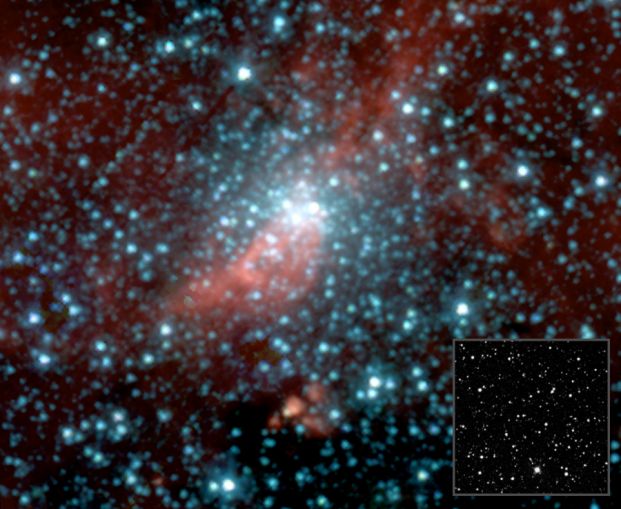Credit & Copyright: H. Kobulnicky
(Univ. of Wyoming)
et al.,
JPL,
Caltech,
NASA
(Visible Light Inset: DSS)
Explanation:
Not a glimpse of
this cluster of stars
can be seen
in the inset visible light image (lower right).
Still,
the infrared view
from the Spitzer
Space Telescope reveals
a massive globular star cluster of about 300,000 suns in
an apparently empty region of sky in the constellation Aquila.
When astronomers used Spitzer's
infrared cameras to peer
through obscuring dust in the plane of our
Milky Way galaxy,
they were rewarded with the surprise discovery of the
star cluster, likely one of the last such
star clusters
to be found.
Globular star clusters normally
roam
the halo of the Milky Way,
ancient relics
of our galaxy's formative years.
Yet the Spitzer image shows this otherwise hidden cluster
crossing through
the middle of the galactic plane some 10,000 light-years away.
At that distance, the picture spans only about 20 light-years.
In the false color infrared image, the red streak is a dust cloud
which seems to lie behind the cluster core.
(Visible Light Inset: DSS)
1999 2000 2001 2002 2003 2004 2005 2006 2007 2008 2009 2010 2011 2012 2013 2014 2015 2016 2017 2018 2019 2020 2021 2022 2023 2024 2025 |
Yanvar' Fevral' Mart Aprel' Mai Iyun' Iyul' Avgust Sentyabr' Oktyabr' Noyabr' Dekabr' |
NASA Web Site Statements, Warnings, and Disclaimers
NASA Official: Jay Norris. Specific rights apply.
A service of: LHEA at NASA / GSFC
& Michigan Tech. U.
|
Publikacii s klyuchevymi slovami:
infrared - Spitzer space telescope - globular cluster - infrakrasnoe izluchenie - Sharovoe skoplenie
Publikacii so slovami: infrared - Spitzer space telescope - globular cluster - infrakrasnoe izluchenie - Sharovoe skoplenie | |
Sm. takzhe:
Vse publikacii na tu zhe temu >> | |
